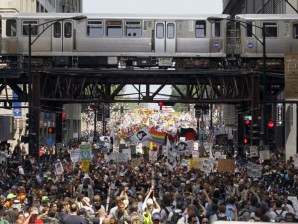CHICAGO — Thousands of demonstrators upset with the war in Afghanistan, climate change and the erosion of union rights marched through downtown Chicago on Sunday, taking their discontent on a wide range of world issues to leaders assembled for a NATO summit.

Demonstrators flow out of Grant Park in Chicago during this weekend's NATO summit Sunday, May 20, 2012 in Chicago. AP/Charles Rex Arbogast
The protest, one of the city’s largest in years, was to end at the lakeside convention center hosting the two-day meeting, which is focused on the war in Afghanistan, European missile defense and other international security matters.
Some participants called for the dissolution of NATO, the 63-year-old military alliance that is holding its 25th formal meeting in Chicago. It is the first time the summit has been held in a U.S. city other than Washington.
“Basically NATO is used to keep the poor poor and the rich rich,” said John Schraufnagel, who traveled from Minneapolis to Chicago for the march. Since the end of the Cold War, he said, the alliance has become “the enforcement arm of the ruling 1 percent, of the capitalist 1 percent.”
Peace activists joined with war veterans and people more focused on the economy. Marchers assembled at Grant Park with signs denouncing NATO, including ones that read: “War(equals)Debt” and “NATO, Go Home.”
But the crowd was mostly filled with protesters whose primary concerns had little to do with the discussions at the summit.
The march lacked the size and single message that shaped the last major protest moment in Chicago, when nearly half a million people filled the city’s downtown in 2006 to protest making it a felony to be an illegal immigrant.
The only disruption in an otherwise peaceful protest happened when dozens of protesters in black clothing surged toward a much smaller group of police, throwing objects at them.
The badly outnumbered officers fought back with truncheons, and people on both sides threw punches. As police reinforcements moved in, the pack of violent protesters fled.
Authorities had planned for months to provide heightened security along the march route to protect people and property.
But unseasonably warm temperatures raised concerns about the safety of the marchers themselves. The city provided water, rest stations and cooling buses along the 2½-mile (four-kilometer) protest route.
The heat offered an unexpected benefit for police: making it easier to spot potential troublemakers.
Before the summit, officers were told to keep an eye out for people wearing bulky clothing that could hide weapons or big pieces of cardboard that protesters could use to shield themselves against rubber bullets. But anyone wearing overcoats or sweatshirts was conspicuous on a 90-degree Fahrenheit (32-degree Celsius) day, when many people wore T-shirts and shorts.
Organizers of Sunday’s rally had initially predicted tens of thousands of protesters this weekend. But that was when the G-8 summit of leading industrial nations was also scheduled to be in Chicago. Earlier this year, President Barack Obama moved the Group of 8 economic meeting to Camp David, the secluded presidential retreat in rural Maryland.
Chicago kept the NATO summit, which is not addressing the economy specifically. That left activists with the challenge of persuading groups as diverse as teachers, nurses and union laborers to show up for the Chicago protests even though the summit’s main focus doesn’t align with their most heart-felt issues.
Sunday’s protest followed several smaller demonstrations over the previous two days, including a march Saturday to the home of Mayor Rahm Emanuel, Obama’s former chief of staff.
Later that evening, hundreds of demonstrators zigzagged through downtown, some decrying terrorism-related charges leveled against three young men earlier in the day. Eighteen people were arrested.
Police Supt. Garry McCarthy said officers would be ready with quick but targeted arrests of any demonstrators who turn violent.
“If anything else happens, the plan is to go in and get the people who create the violent acts, take them out of the crowd and arrest them,” warned McCarthy. “We’re not going to charge the crowd wholesale — that’s the bottom line.”
Three activists who traveled to Chicago for the summit were accused Saturday of manufacturing Molotov cocktails in a plot to attack Obama’s campaign headquarters, Emanuel’s home and other targets.
Defense lawyers argued that the police had trumped up the charges to frighten away peaceful protesters. They told a judge it was undercover officers who brought the firebombs to an apartment in Chicago’s South Side where the men were arrested.
On Sunday, police said two other men were in custody after being accused of planning to make Molotov cocktails to be used during the NATO summit.
Sebastian Senakiewicz, 24, was charged with one felony count of terrorism/making a false threat. Mark Neiweem, 28, was charged with attempted possession of explosives. Both men were scheduled to appear in court later Sunday.
It was not immediately clear if those arrests were related to the other three.
Kris Hermes of the National Lawyers Guild said the charges seem to be part of a wider effort to scare people and diminish the size of the demonstrations.